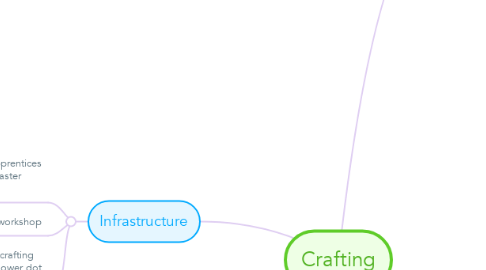
1. Infrastructure
1.1. Side system, represents skilled apprentices and craftsmen working under a master craftsman
1.2. Maximum based on workshop
1.3. Can be used to alleviate crafting requirements by making lower dot prerequisites
2. Preperation
2.1. Includes Workshop and Tools
2.1.1. Workshop
2.1.1.1. Determines maximum number of consecutive projects
2.1.1.2. Also determines the highest difficulty of project attempted
2.1.1.2.1. A basic carpentry shop could support 3 difficulty of wood crafting
2.1.1.2.2. A well equipped palace kitchen could handle 7 difficulty of water crafting (allowing many meals, several feasts, or artifact level meals and poisons to be made)
2.1.1.2.3. A factory-cathedral in the first age could support 20 or more difficulty of simultaneous projects, facilitating the crafting of N/A level artifacts
2.1.1.3. Can only support certain broad groups of crafts (theoretically elemental split)
2.1.2. Tools
2.1.2.1. Every project requires 1-3 tools
2.1.2.1.1. 3 tools per project max
2.1.2.2. Tools can be used on Interval, Threshold, or Difficulty
2.1.2.3. Average tools have no affect past allowing crafting, higher quality and artifact tools have special affects
2.1.2.3.1. Most average tools don't need to be tracked the majority of the time, other then for dramatic purposes. It can be assumed a blacksmith shop has a hammer and anvil.
2.1.2.4. Tools can affect abilities and evocations of artifacts
2.1.2.5. Many tools are portable (hammers, smoothing planes, universal crafting bracers), but most are in a workshop (anvils, forges, brick molds, kilns)
3. Materials
3.1. 1 or 2 dot, basic materials
3.2. 3, 4, 5, requires (dots - 1) number of (dots - 2)
3.2.1. 3 requires 2 1 dots
3.2.1.1. For example, a well made sword (or daiklaive) would need a blade and hilt (or a hearthstone socket)
3.2.2. 4 requires 3 2 dots (which may be unique resources for artifacts)
3.2.2.1. For example, a Trebuchet would need a chasis, pully, and longarm
3.2.3. 5 requires 4 3 dots (which could mean many 1 dots, or several unique resources, or a mix)
3.2.3.1. For example, a Daiklaive of Conquest could use a hearthstone channel, a broken spirit, a grand daiklaive, and the crown of a spirit king
3.3. N/A requirements determined by artifact
3.3.1. For example, the Five Metal Shrike would require 5 level 5 artifacts
4. Difficulty
4.1. Determined by individual project
4.2. Split into Interval, Threshold, and Difficulty
4.2.1. Interval: Time for each roll
4.2.1.1. Average based on difficulty
4.2.2. Threshold: How many successes it takes to complete project
4.2.2.1. Average is Difficulty ^ 2
4.2.2.1.1. Or 2 for 1 dots
4.2.3. Difficulty: How difficult each roll is
4.2.3.1. Average for normal crafting is dot rating in resources
4.2.3.2. Average for artifacts and manses is dot rating + 5
4.2.3.3. If rushing a higher dot craft, add the difficulty of skipped steps to the difficulty of the final project
4.2.3.3.1. For example, a fine sword (difficulty 3, threshold 9, interval 1 day) would require a blade and a hilt (each difficulty 1, threshold 2, interval 1 day). If the smith was trying to rush it out, they could attempt the full project at difficulty 5, threshold 9, interval 1 day. A difficult task, but possible for an Exalted smith.
4.2.3.3.2. Another example would be the Trebuchet (difficulty 4, threshold 20, interval 1 week), which requires a pully, chasis, and longarm (each difficulty 3, threshold 10, interval 1 day). To rush a Trebuchet fully would be difficulty 13, threshold 20, interval 1 week. Much more difficult, even for a skilled Exalt, but possibly worth the risk.

